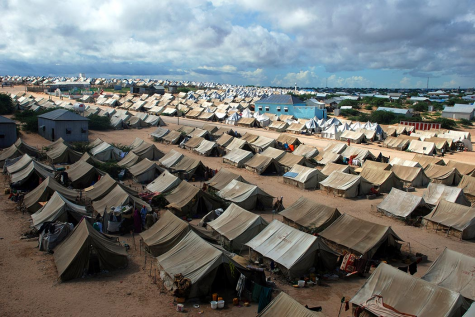The End of The World As We Know It: Starved Earth
This is an ongoing column called The End of the World As We Know It, where I will attempt to show you what our future will look like if we continue to destroy the environment at our current rate. These stories may seem like worst-case scenarios. They are not. Based on predictions from leading scientists and my own personal experiences, know that, without a significant change, this is our future. Thank you for reading.

April 10, 2019

The thirteen-year-old man darts between the city of tents, wishing for the thousandth time for some sort of organization. He slips through the thronging crowd. Just as he closes in on his family’s tent, he is knocked aside by a passerby. He trips and falls, splashing into the improvised waste management trench. The man stands, brushes himself off, and unleashes a string of curses that would’ve made a sailor from the wasteland previously known as Russia blush.
At last reaching the tent, the thirteen-year-old man slips between thin canvas flaps. His mother looks up from where she cares for his brother, his sister, and two of his orphaned cousins. The cholera epidemic was sweeping through the city, cutting down people left and right. His mother gave him a hopeful look.
The man reaches into his small satchel and retrieves two bottles of water and a small vial that contained two pills. His mother shakes her head. “That’s it? You guys have been working non-stop for the last few days.”
The man only stares, his young faced disturbingly contrasted against the aged look in his eyes. “No one has any money. No one has any water. It took every last dollar and most of our food just to secure this much.”
His mother turns and looks at the coughing, crying, dying forms of her children and nieces. She longed to cry, but fought back the tears. She can’t afford to waste the water. She spares a quick thought to think back to her own childhood for a single instant. When there was enough food to go around. When there was enough space for families to live in homes or apartments, rather than these tents. When clean water and medicine were not luxuries. When disease didn’t tear through families like a hot knife through butter. When resources were plentiful. When children didn’t need to go to work. When they didn’t grow up by ten years old.
She shakes her head and sets about deciding which of her four sick family members she will save.
************************
Our world is quickly headed towards disaster. Our population is astronomically high — 7.7 billion — and it is still growing at a ridiculous rate. For example, between the years of 1900 and 2000, the increase in population was three times greater than the number of people born before 1900. Now, our huge population itself is not really an issue. It gives us greater production capacity, making products and services cheaper, allows for extreme levels of job specialization, and greatly increases the rate of discovery, as there are many intelligent people researching everything from a cure to cancer to interstellar exploration to nanotechnology.
However, even with all of these intelligent scientists working daily to solve the world’s problems, there is a storm on the horizon—resource depletion. In an average day, each person from the western world will use 125 pounds of various mined materials. Plastic waste contains oil, gasoline contains oil and various metals (nickel, arsenic, antimony, mercury, etc.), we consume food that was produced using nitrogen or phosphorus, the heating for our buildings comes from electricity produced by coal, we cook with natural gas, we drink and cook with water — the list goes on and on. What’s worse, our consumption frenzy is getting worse with our increase in population. The production of mined resources is expected to increase by 350% by 2030.
If we don’t make changes to our consumption and production habits soon, our economy will likely collapse from the sudden shock of our oil wells going dry, our coal and phosphorous deposits disappearing, and our fresh water evaporating. Coal is only expected to last 150 more years. Oil and natural gas? 50. Phosphorus? 75 more years.
************************
Many of you may think “this is not my problem, I’ll be dead by then.” Well, first of all, our life-expectancy is continuously rising, so you may, in fact, survive for 75-100 more years. But even if that is not the case, this will be your children’s problem. And their children’s problem. If we aren’t careful, if we don’t quickly begin to switch to renewable resources, then, when our coal, when our gas, when our oil all run out, the world in the story above will become our reality. Our world will become a Starved Earth.






